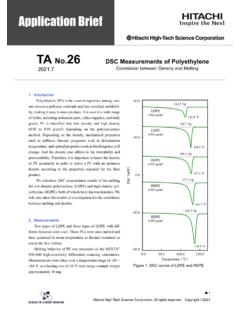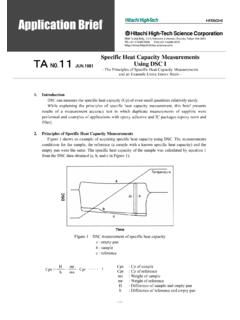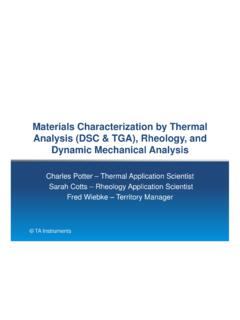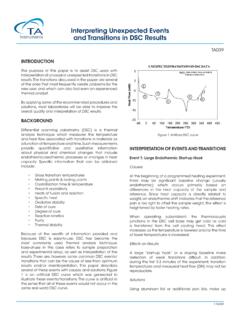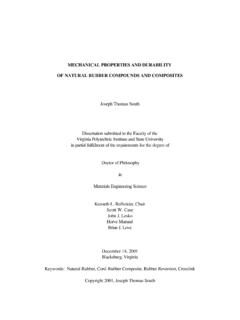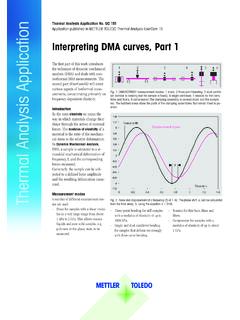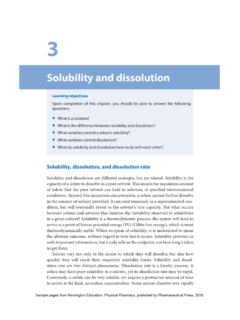Transcription of DSC Measurement of Polypropylene - Hitachi High-Tech
1 TA DSC Measurement of Polypropylene The effects of heat treatment on polymer crystallinity Copyright Hitachi High-Tech Science Corporation All rights reserved. 1 1. Introduction Polypropylene (PP) is a crystalline polymer that is cheap, excellent formability, resist water, chemical resistant and high strength. Due to these charac-teristics, it is used as a general-purpose plastic in a wide variety of products, including food packaging, electrical products, medical materials, car parts and synthetic paper. When PP is formed, its crystal formation changes according to the heat treatment temperature and the conditions of the cooling process.
2 These changes create differences in strength, heat resistance and pressure bonding properties. Food-related products may be thermally sterilized after packaging. There-fore, it is important to understand how to manage the desired crystallized state for the product and the effects of heat treatment on crystallinity. In this brief, differential scanning calorimetry (DSC) is used to evaluate the crystallinity of PP molds. 2. Measurement The samples were commercially-available PP sheets. The DSC7020 differential scanning calo-rimeter was used for the measurements. Measurement condition 1 evaluated the tempera-ture dependence of crystal structure.
3 An untreated sample weighing was heated from room tem-perature to 200 C at 10 C/min in a nitrogen at-mosphere. In addition, thermally treated samples were created by heating them to 110, 115, and 120 C and the quench them. These samples were then measured under the same conditions as condi-tion 1. Measurement condition 2 evaluated the tempera-ture dependence of crystallization . Samples weighing 3mg were heated to 200 C in a nitrogen atmosphere to melt them. Next, they were quenched to 120, 123, 125, 127 or 130 C and held at that temperature for 15 to 50 minutes. 3. Results The effects of heat treatment on PP crystallinity Figure 1 shows the DSC curves for Measurement condition 1.
4 All samples showed an endothermic peak due to PP melting around 160 C. Furthermore, on the low temperature side of the endothermic peak, the untreated sample showed a smooth DSC curve between 110 and 125 C while the treated samples showed a minute peak. Figure 2 enlarges the results around 120 C. The treated samples showed minute endothermic peaks of several tens of W near their heat treatment tem-peratures. Each heat treatment temperature pro-duced a different crystal structure. The peaks in the figure are considered the melting points of these structures during DSC Measurement . Copyright Hitachi High-Tech Science Corporation All rights reserved.
5 2 Temp. C 110 C 115 C 120 C Temp. C 110 C 115 C 120 C Figure 1 DSC curves for Measurement Condition 1 Temp. C 110 C 115 C 120 C Temp. C 110 C 115 C 120 C Figure 2 Enlarged views of the DSC curves for Figure 1 Measurement of isothermal crystallization Figure 3 shows the DSC curves for Measurement condition 2. PP crystallization produced an exo-thermic peak at each holding temperature. The lower the holding temperature, the sharper the peak and the earlier the peak top occurred. The higher the holding temperature, the broader the peak and the later the peak top occurred.
6 This occurred because the higher the temperature, the greater the freedom of molecular motion, which makes crystallization more difficult and increases the time required for crystallization to be completed. The relation of crystallization temperature and crystallization time can be investigated using these results. 4. Summary In this brief, DSC measurements of PP sheets were used to investigate crystallization differences caused by heat treatments and different heat treatment temperatures. The results showed the effects of heat treatment during formation. These results make it possible to determine the appropriateness of heat treatment conditions and infer what kind of heat treatment was performed.
7 Agents are sometimes added to PP molds, in-cluding additives such as antioxidants and nucleating additives to stimulate crystallization or whiten products. Furthermore, crystal growth may differ by formation temperature due to the presence of crystal nucleus, even after melting. DSC Measurement of isothermal crystallization is effective in evaluating these characteristics and shows the effects of addi-tives and appropriateness of formation temperature. Time Figure 3 DSC curves for Measurement Condition 2
